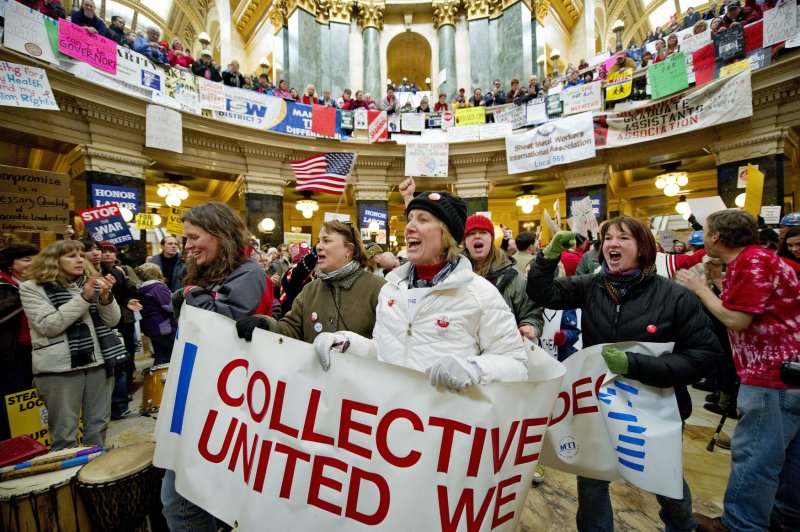Teachers march through the rotunda at the state Capitol to protest pending budget legislation in Madison, Wisconsin on February 24, 2011. Protests continued for the 11th day as a bill slashing benefits and revoking collective bargaining rights from state workers nears passage. UPI/Brian Kersey |
License Photo
COLLEGE PARK, Md., March 1 (UPI) -- The drama playing out in Wisconsin and public reaction illustrates why unions have America's governors and legislatures hogtied and states teetering on insolvency.
Over the last half century two powerful trends have defined America's labor movement. Competition and a changing workforce have marginalized private sector unions, while public sector unions have grown in clout.
Unions represent less than 7 percent of non-government workers, down from 32 percent in 1960, while public unions have increased strength to 36 percent of workers from less than 25 percent in 1960.
In the private sector, an increasingly well-educated and professional labor force finds unions irrelevant and won't vote yes for unions in representation elections. For blue collar workers, global competition steals union leverage in many industries -- if workers negotiate wages and benefits that employers can't pass on to consumers and businesses fail, union contracts become worthless.
In the public sector, unions have special appeal because their employers enjoy a monopoly and union workers don't face much accountability. If service is lousy at the Motor Vehicle Bureau or teachers don't teach, taxpayers can't go down the street to another vendor to renew their driver's licenses and most can't afford private school tuition.
Moreover, public unions use dues to ensure their bosses -- governors and key legislators -- support generous benefits package and turn a blind eye to abuses of tenure.
Often, local unions don't even have to negotiate for excessive compensation. New York Mayor Michael Bloomberg complains state law imposes pension benefits for teachers but the city must raise the taxes to finance those and tenure rules are established by state law. Essentially, corruption in Albany, N.Y. -- union campaign contributions in exchange for votes in the state legislature -- makes running New York City schools awfully tough for even a man as talented as Michael Bloomberg.
Nationally, left-leaning AFL-CIO and member unions use dues to finance a formidable political machine that helped pass Medicaid laws forcing the states to finance the worst abuses of federal healthcare policy -- the absence of genuine competition in the drug and health services markets and torts lawyers terrorizing physicians.
That drama is replayed in other expensive areas of federal policy handicapping the states.
No surprise that resolving state budget deficits come down to trimming pension and healthcare benefits for public workers and the abuse of union dues, and lobbying Washington for relief from Medicaid and other federal mandates.
Now organized labor's political strategy has backfired. Many states are essentially insolvent but can't seek court reorganization of their debts. Unlike with private businesses, government assets -- statehouses, schools, libraries and such -- can't be awarded by courts to creditors in lieu of payment.
Last week, Illinois sold bonds due in 2019 by paying a whopping 5.9 percent rate. Factoring in the tax-free status of those bonds, that's about 40 percent higher than corporate junk bonds.
The bond market recognizes, unlike New York City in the 1980s, the federal government, with a deficit 11 percent of gross domestic product, can't bail out the states without succumbing to a fate worse than Greece.
Wisconsin Gov. Scott Walker and leaders in other states are seeking to rebalance the relationship between public employers and organized labor but polls indicate most Americans don't want to curtail government employees' collectively bargaining rights.
Even if the typical voter finds unions irrelevant to his circumstances, it seems unfair to deny freedom of association.
Voters don't seem to grasp that public unions often become the government and the employer on the other side of the collective bargaining table. Consequently, now taxpayers face skyrocketing taxes, curtailed public services and ultimately governments driven to default.
Media reports highlighting voters' pro-union public sentiment misses the point. Debate should focus on establishing a fair balance between worker rights and the public interest. That requires that public employees not be compelled to join a union and public unions shouldn't be able to use dues to undertake political activities. Periodically, unions should be subject to recertification elections -- not every year, as Walker would like, but perhaps every three years.
Compromise would preserve the balance between freedom of association and fiscally sound government. Such a solution would embody true American values -- freedom of choice, democratic decision making and clean government.
--
(Peter Morici is a professor at the Smith School of Business, University of Maryland School, and former chief economist at the U.S. International Trade Commission.)
--
(United Press International's "Outside View" commentaries are written by outside contributors who specialize in a variety of important issues. The views expressed do not necessarily reflect those of United Press International. In the interests of creating an open forum, original submissions are invited.)















